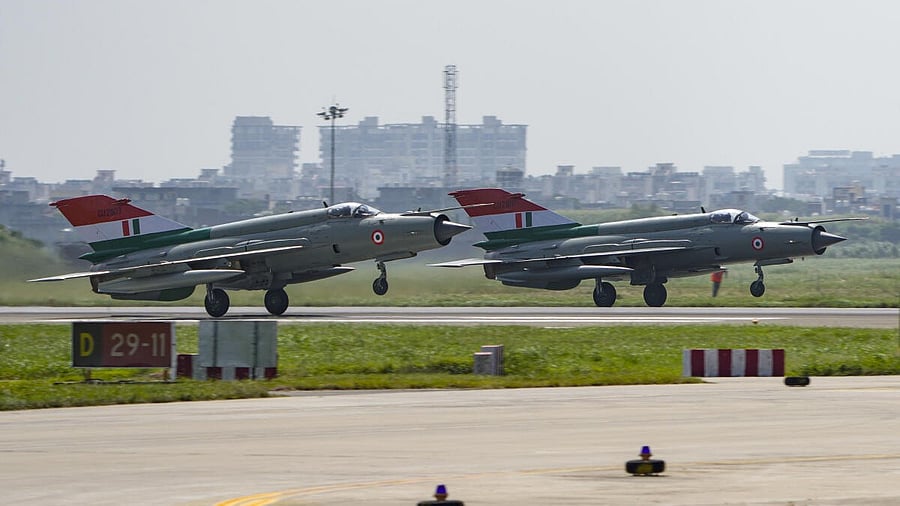
Indian Air Force MiG-21 aircraft during the ‘MiG-21 Operational Flying Culmination Ceremony’ at Chandigarh Air Force Station (AFS), Friday, Sept. 26, 2025.
Credit: PTI Photo
Chandigarh: From its precision strike at the Governor’s House in Dhaka during the 1971 campaign to neutralising Pakistan Navy’s Atlantique spy plane post Kargil and shooting down a superior Pakistani F-16 combat jet during the Balakot air raid – the formidable MiG-21 always remains at the core of the Indian Air Force’s moments of glory.
Not any more. After 62 years of service, the IAF on Friday bid adieu to the mighty fighters at a glittering ceremony at Chandigarh Air Station where the first unit - 28 Squadron, also known as the First Supersonics – was raised with six aircraft.
Over the years, the IAF operated 874 aircraft, nearly 600 of which were made in India by Hindustan Aeronautics Limited. Despite the accidents, it retained its reputation and pilots who flew the aircraft swear by it.
“I have flown Mig-21 for 26 years. Its reputation was so good during the 1965 war that Pakistanis didn’t fly their supersonics. In 1971, it directly got involved and 80% of credit in the formation of Bangladesh should go to MiG-21,” said Air Commodore S S Tyagi, who has flown the MiG-21 for 4,306 hours, the maximum in the IAF.
The Russian origin jet was inducted originally as an interceptor, but the IAF modified its role and used it for ground attack, air defence, surveillance (thanks to an innovation made during the 1971 war) and training. During Operation Sindoor, it was used for surveillance and reconnaissance.
“After all these years, it is not merely a fighter aircraft but a family member. No one can forget the strike on the Governor House in Dhaka that decided the outcome of the war,” Defence Minister Rajnath Singh said at the event attended by over 2,000 IAF veterans and their families who have been a part of the MiG-21’s journey.
“For a long time, Mig-21 has been a witness to numerous heroic deeds. Its contribution has not been limited to a single event or single war. From the war of 1971 to Kargil conflict, from the Balakot airstrike to Operation Sindoor, there has not been a moment when MiG-21 didn’t provide strength to the forces,” the minister said.
The aircraft’s final sortie was led by Chief of the Air Staff Air Chief Marshal A P Singh and Squadron Leader Priya Sharma – one of the IAF’s women combat pilots – were among the six pilots mostly from 23 Squadron who were at the cockpit of the last batch of MiG-21s that took the skies for a flypast. From now on, the aircraft will be a part of the heritage squadron.
Group Captain Rajender Nanda - the Commanding Officer of the 23 Squadron – the last MiG-21 unit that was decommissioned – was among the six, who flew with the IAF chief. This is symbolic because he is. The same unit is slated to get the first batch of Tejas LCA Mk-1A, which will replace the MiG-21s.
On frequent accidents because of which the aircraft earned monikers like “flying coffin” and “widow-maker”, the minister said the aircraft being flown currently were about 40 years old as the aircraft that came in the 1960s and 1970 have retired long ago.
